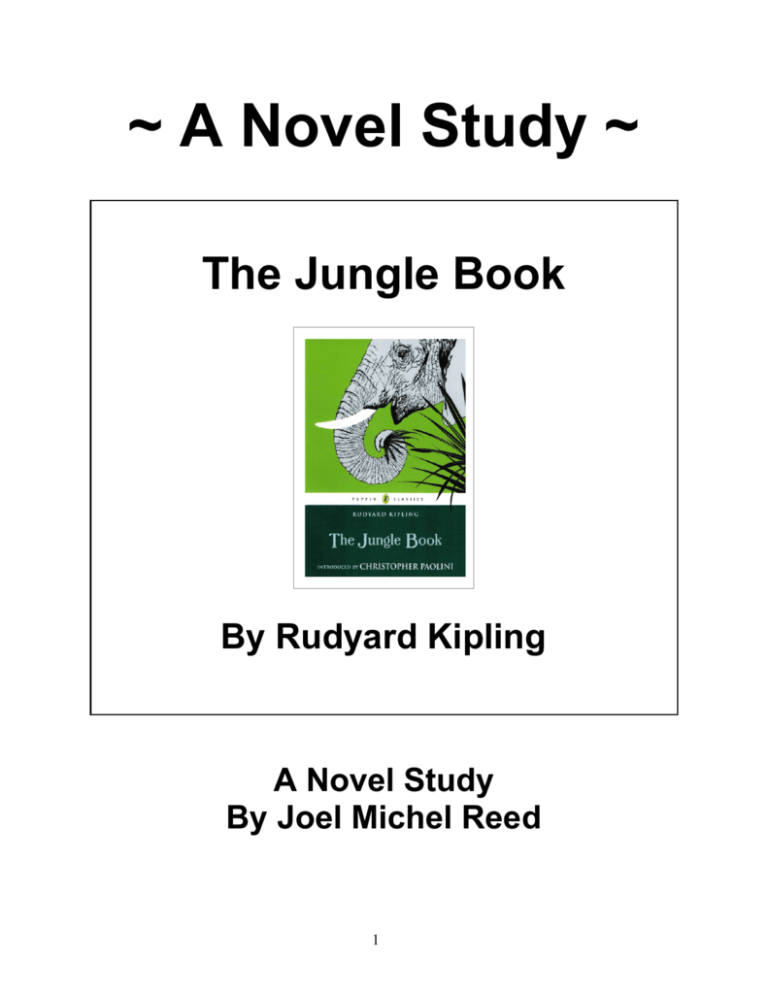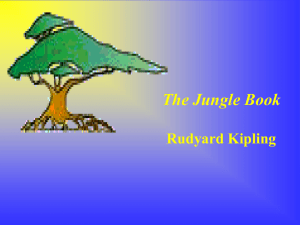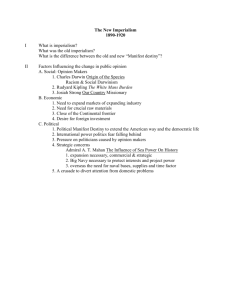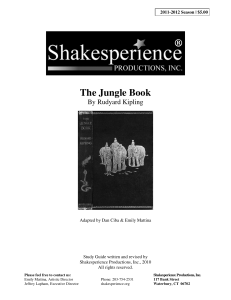
~ A Novel Study ~
The Jungle Book
By Rudyard Kipling
A Novel Study
By Joel Michel Reed
1
The Jungle Book
By Rudyard Kipling
Table of Contents
Suggestions and Expectations ..……………………………………….
3
List of Skills ….……………………………….…………………………..
4
Synopsis / Author Biography …..…………………………………......
5
Student Checklist ………………………………………………………..
6
Reproducible Student Booklet ..………………………………………..
7
Answer Key ...……………………………………………………………...
45
About the author: Joel Reed has over 40 published novel studies and is the coauthor of three fiction novels. For more information on his work and literature, please
visit the websites www.reedpublications.org and www.novelstudies.org.
Copyright © 2014 Joel Reed
All rights reserved by author.
Permission to copy for single classroom use only.
Electronic distribution limited to single classroom use only.
Not for public display.
2
The Jungle Book
By Rudyard Kipling
Suggestions and Expectations
This curriculum unit can be used in a variety of ways. Each chapter of the novel study
focuses on two or three chapters of The Jungle Book and is comprised of five of the
following different activities:
•
•
•
•
•
Before You Read
Vocabulary Building
Comprehension Questions
Language Activities
Extension Activities
Links with the Common Core Standards (U.S.)
Many of the activities in this unit are supported by the Common Core Standards. For
instance the Reading Standards for Literature, Grade 5, makes reference to
a) determining the meaning of words and phrases. . . including figurative language;
b) explaining how a series of chapters fits together to provide the overall structure;
c) compare and contrast two characters;
d) determine how characters … respond to challenges;
e) drawing inferences from the text;
f) determining a theme of a story . . . and many others.
A principal expectation of the unit is that students will develop their skills in reading,
writing, listening and oral communication, as well as in reasoning and critical thinking.
Students will also be expected to provide clear answers to questions and wellconstructed explanations. It is critical as well that students be able to relate events and
the feelings of characters to their own lives and experiences and describe their own
interpretation of a particular passage.
A strength of the unit is that students can work on the activities at their own pace. Every
activity need not be completed by all students. A portfolio cover is included (p.7) so
that students may organize their work and keep it all in one place. A Student Checklist
is also included (p.6) so that a record of completed work may be recorded.
3
The Jungle Book
By Rudyard Kipling
List of Skills
Vocabulary Development
1. Locating descriptive words / phrases
2. Listing synonyms/homonyms
3. Identifying / creating alliteration
4. Use of capitals and punctuation
5. Identify foreshadowing.
6. Identify personification
7.
8.
9.
10.
11.
Determining Alphabetical Order
Listing compound words
Identifying parts of speech
Identifying syllables
Identify/create similes
Setting Activities
1. Summarize the details of a setting
Plot Activities
1. Complete a time line of events
4. Identify cliffhangers
5. Identify the climax of the novel/story.
2. Identify conflict in the story
3. Complete Five W's Chart
Character Activities
1. Determine character traits
2. Relating personal experiences
Creative and Critical Thinking
1.
2.
3.
4.
Research
Write a newspaper story
5.
6.
7.
8.
Create a short story
Create a poem
Write a description of personal feelings
Write a book review
Complete an Observation Sheet
Complete a KWS Chart
Art Activities
1. A Storyboard
2. Create a collage
3. Create an Information Card
4. Design a cover for the novel
5. Create a comic strip
4
The Jungle Book
By Rudyard Kipling
Synopsis
After young Mowgli escapes the vicious jaws of the growling tiger Shere Khan, he is adopted
by Father Wolf and grows up with the pack. Lovable old Baloo the bear and Bagheera the
Panther teach Mowgli the Law of the Jungle, and so his extraordinary adventures begin!
(Publisher – Puffin Classics)
A complete synopsis and other helpful reviews can be found on the following website:
http://en.wikipedia.org/wiki/The_Jungle_Book
Author Biography
Rudyard Kipling
Joseph Rudyard Kipling (30 December 1865 – 18 January
1936) was an English short-story writer, poet, and novelist. He is
chiefly remembered for his tales and poems of British soldiers in
India and his tales for children. He was born in Bombay, in the
Bombay Presidency of British India, and was taken by his family
to England when he was five years old. Kipling is best known for
his works of fiction, including The Jungle Book (a collection of
stories which includes "Rikki-Tikki-Tavi"), Just So Stories (1902),
Kim (1901) (a tale of adventure), many short stories, including
"The Man Who Would Be King" (1888); and his poems, including
"Mandalay" (1890), "Gunga Din" (1890), "The Gods of the
Copybook Headings" (1919), " The White Man's Burden" (1899),
and "If_” (1910). He is regarded as a major "innovator in the art
of the short story"; his children's books are enduring classics of
children's literature; and his best works are said to exhibit "a
versatile and luminous narrative gift".
Courtesy of Wikipedia: http://en.wikipedia.org/wiki/Rudyard_Kipling
5
The Jungle Book
By Rudyard Kipling
Student Checklist
Student Name:
Assignment
Grade/Level
6
Comments
The Jungle Book
By Rudyard Kipling
Name:
7
The Jungle Book
By Rudyard Kipling
Chapters 1-2
Before you read the chapter:
The protagonist in most novels features the main character or “good guy”. What do you think
makes for an especially interesting protagonist?
Vocabulary:
Choose a word from the list to complete each sentence.
teacher
thickets
withdraw
leave
twitching
furious
entered
madness
1.
Even the tiger runs and hides when little Tabaqui goes mad, for ___________ is the most
disgraceful thing that can overtake a wild creature.
2.
"I go," said Tabaqui quietly. "Ye can hear Shere Khan below in the __________. I might
have saved myself the message."
3.
"Something is coming uphill," said Mother Wolf, ___________ one ear. "Get ready."
4.
Shere Khan had jumped at a woodcutter's campfire, as Father Wolf had said, and was
___________ from the pain of his burned feet.
8
5.
The Law of the Jungle lays down very clearly that any wolf may, when he marries,
____________ from the Pack he belongs to.
6.
Let him run with the Pack, and be _________ with the others. I myself will teach him."
7.
"We need yet another," said Akela. "Baloo has spoken, and he is our ___________ for
the young cubs. Who speaks besides Baloo?"
8.
"Knowing that I have no right to speak here, I ask your __________."
Questions
1. Describe the setting of the story as Chapter One begins.
2. Define the term 'Hydrophobia'.
3. Why did Father Wolf believe it was wrong to hunt man?
4. At what cost was Mowgli able to enter into the pack?
5. What did Bagheera mean by the term 'Red Flower'?
9
6. Briefly describe the incident that took place during the second council meeting.
Language Activity
A.
A simile is a comparison using the words “like” or “as”. An example from Chapter
One is “. . . Mother Wolf shook herself clear of the cubs and sprang forward, her eyes,
like two green moons in the darkness, facing the blazing eyes of Shere Khan. "
What two things are being compared in this example?
Write a simile comparing the following items with something from your own imagination:
a) A car speeding down a highway.
b) A plane landing on a runway.
10
B.
Chapter 1 contained an important literary devices called a
cliffhanger. A cliffhanger usually occurs at the end of a chapter when the
author leaves the reader in suspense.How is this true in Chapter 1? Why
do you think the author ended the chapter this way?
C.
Foreshadowing is a literary device used by authors to provide clues for the reader
so they are able to predict what might occur later in the story. How might the following
statement be considered an example of this literary device: "Assuredly I will keep him.
Lie still, little frog. O thou Mowgli—for Mowgli the Frog I will call thee—the time will
come when thou wilt hunt Shere Khan as he has hunted thee."
11
Extension Activity
Storyboard
A storyboard is a series of pictures that tell about an important event in a story. A
storyboard can tell the story of only one scene – or the entire novel.
Complete the storyboard below illustrating the events described in the last two chapters
of the novel. You may wish to practice your drawings on a separate piece of paper.
1
2
3
4
5
6
12












